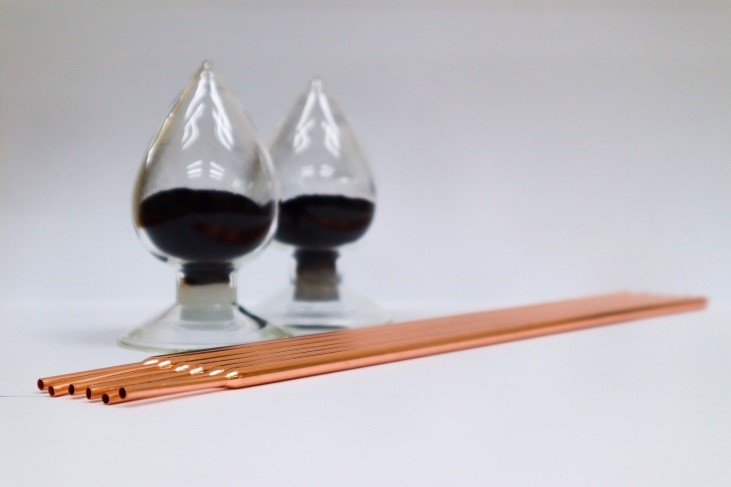- 回首頁
- 機械工業雜誌
- 歷史雜誌
摘要:在淨零碳排的國際趨勢下,全球發展電動車的浪潮已風起雲湧。隨著電池的功率密度逐年提升,電池的發熱量也隨之增加。由於電池的溫度會影響充放電的性能,甚至過高的溫度將導致電池起火,嚴重危害人員的安全。因此,電動車電池的熱管理系統已成為研發關鍵。針對高功率密度電池的開發,以傳統冷卻液管路進行散熱面臨了重大的瓶頸。相較於水冷式管路,熱管具有許多優點,如高單位體積排熱率等。本文透過開發石墨烯奈米流體的製備方法與石墨烯熱管,以解決高功率密度電池的散熱問題。經由不同的實驗參數,包含石墨烯比例、流體選用、黏滯性、潛熱、表面張力、密度、幾何尺寸等等,以找出最佳的散熱結果。由實驗的散熱結果可知,在石墨烯熱管方面,添加石墨烯奈米流體後,最大熱傳量比純水提升45%,熱傳導係數提升約120%。對於石墨烯脈衝熱管,添加石墨烯奈米流體後,最大熱傳量比純水提升130%,熱傳導係數提升約50%。石墨烯脈衝熱管比石墨烯熱管具有更大熱傳量,因此將來可應用至電動車的電池,達成高效散熱的目標,對於發展高功率密度電池有極大的助益。
Abstract:Under the international trend of net zero carbon emissions, the wave of global development of electric vehicles has been surging. As the power density of the battery increases year by year, the heat generated by of the battery also increases. Since the temperature of the battery will affect the performance of charging and discharging, excessive temperature may even cause the battery to catch fire, seriously endangering personnel safety. Therefore, the thermal management system of electric vehicle batteries has become the key to research and development. For the development of high power density batteries, the traditional cooling liquid pipeline for heat dissipation faces a major bottleneck. Compared to water-cooled pipes, heat pipes have many advantages, such as high heat transfer rate per unit volume. In this article, the graphene nanofluids and graphene heat pipes preparation methods are developed to solve the heat dissipation problem of high power density batteries. Through different experimental parameters, including graphene ratio, fluid selection, viscosity, latent heat, surface tension, density, geometric size, etc., to find the best heat dissipation results. The results show that the heat dissipation of the experimental graphene heat pipes, after adding graphene nanofluids, the maximum heat transfer rate is increased by 45% compared to pure water, and the thermal conductivity coefficient is increased by 120%. As for the graphene pulsating heat pipe, after adding graphene nanofluids, the maximum heat transfer is increased by 130% compared to pure water, and the thermal conductivity is increased by 50%. The graphene pulsating heat pipe has greater heat transfer capacity than the graphene heat pipe, so it can be applied to the battery thermal management system of electric vehicles to achieve the goal of efficient heat dissipation in the future, and provide with great help for the development of high power density batteries.
關鍵詞:石墨烯、熱管、熱管理
Keywords:Graphene, Heat pipe, Thermal management
前言
淨零碳排已是全球對於環境發展的共識,面對這股浪潮各國莫不致力發展電動車[1],以達成淨零碳排的目標。作為電動車儲能和動力來源的關鍵元件的電池,已成為各大廠爭相投入的研發重點。隨著電池的功率密度逐年提升,電池的發熱量隨年增加。若電池的溫度超過45℃將會損害充放電的性能,過高的溫度將導致電池起火,嚴重危害人員的安全。因此如何快速且大量地將熱導離電池以有效散熱,已成一項重要的研究議題。
傳統電動車的電池冷卻系統,如特斯拉使用由50%的水和50%的乙二醇混合而成的冷卻液管路,可有效冷卻100 kWh以下之電池,但仍無法滿足日益增加的高功率密度電池(如200 kWh)的散熱需求。因此,近年來研發人員全力研究高導熱的材料、機制與裝置,以解決高功率密度電池的散熱問題。相較於水冷式管路,熱管具有許多優點,如單位體積排熱率高,無需額外的流體驅動元件,以及極強的適用性。熱管的熱傳導率12,000 W/m-K是銅的30倍,以及鋁的60倍。因此,熱管已廣泛地應用於許多領域,包括太空元件、電腦的中央處理器、太陽能熱水器、汽車引擎冷卻與電子元件冷卻等等。
科學家發現在熱管中添加奈米顆粒可以改變基底流體的傳輸與熱性質,例如懸浮的奈米粒子大幅增加了混合物的熱傳導率,並提高了能量交換能力。在早期,研發人員研究了金屬顆粒如銀的奈米流體對銅脈動熱管熱性能的影響[2],結果顯示,較好的工作液為100 ppm濃度的銀奈米流體,最佳填充率為60%。近年來發現石墨烯具有優異的導熱性能,其熱傳導率高達5,300 W/(m·K)。因此,石墨烯被視為是熱管中有效提升熱傳導率的奈米顆粒的重要材料。
在本文,我們開發石墨烯奈米流體的製備方法與石墨烯熱管,並經由不同的實驗參數,包含:石墨烯比例、流體選用、黏滯性、潛熱、表面張力、密度、幾何尺寸等,找出最佳的散熱結果。此外,將石墨烯脈衝熱管和石墨烯熱管兩者與純水熱管的最大熱傳量進行比較,並得到兩者熱傳導係數提升量。
石墨烯熱管的原理與發展
石墨烯熱管、石墨烯均溫板和石墨烯脈衝熱管如圖1,利用石墨烯二維奈米結構特性,於蒸發區產生成核址(nucleation site),再加熱時快速激發核沸騰產生。將奈米流體導入熱管,最早源自於Maxwell [3]發表電磁學通論,內部除了整合電磁特性理論,另帶來粒子在流體內的混合液體雙相流的新觀念,雖20世紀初期無法製作出奈米流體,Maxwell利用理論預測加入圓形粒子的懸浮液體,熱傳導性能會提升。到了20世紀中期,Hamilton & Crosser [4]認為熱傳應在粒子表面發生,於是控制粒子外型及表面積,修正Maxwell模型,並進一步增加熱傳導率。1975年Ahuja [5]研究粒子的體積、尺寸和流率對熱傳導影響,然而當時尚無法製作出奈米粒子,甚至合適的懸浮劑去做奈米粒子於流體中合適的分離,僅在工作流體中加入微米和毫米尺寸的粒子,卻發現熱傳導率增加,驗證Maxwell的理論預測是正確的。可惜因粒子較大,實驗最終出現微米和毫米尺寸的粒子,阻塞管路甚至造成管路磨損。
在20世紀末期,奈米科技漸漸成熟,Choi & Eastman [6]成為第一個使用氧化銅奈米流體和二氧化鈦奈米流體,在奈米流體中探討熱傳導能力,改善之前的微米粒子和毫米粒子的缺失。目前在奈米材料中,以石墨烯的熱傳導效率最佳,可達到5,300W/mK,遠高於奈米氧化銅粉、奈米氧化鋁粉等材質。

圖1 石墨烯粉末與熱管
更完整的內容歡迎訂購 2022年09月號 (單篇費用:參考材化所定價)
主推方案
無限下載/年 5000元
NT$5,000元
訂閱送出